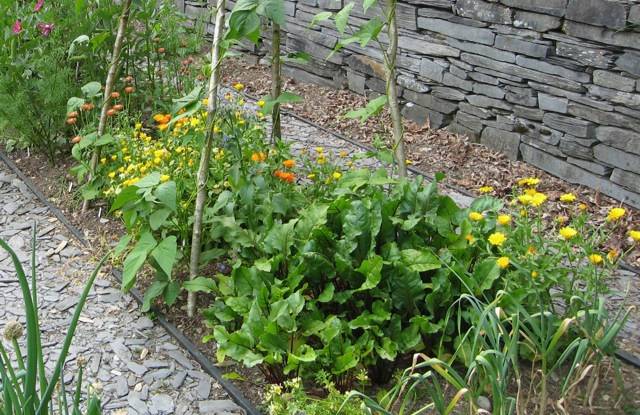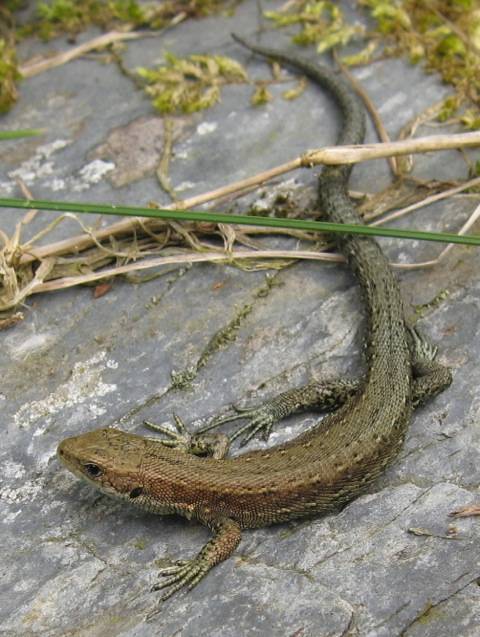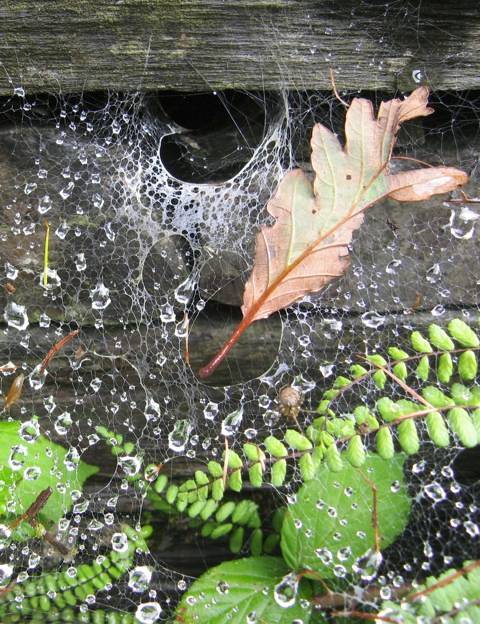Walls, terraces, paths, steps, soil, compost, wildlife habitats… second-hand and spoil heap slate can give you the makings of an entire garden.
Bar the dreaming and hard graft, my garden owes its existence to an ancient and, given its dour demeanour, quite magical ingredient. It’s very tangible, and it’s very heavy. Its straight lines run everywhere, leading the eye along modest vistas. I’ve strained my back carrying it, bruised a toe or two under it, and sliced the odd finger on it. I hurl chunks of it, aiming badly, at smug, raspberry-lipped squirrels. Underfoot, its dull crunch provides an unwavering signature tune (except when muffled by snow). Under midsummer’s flare it’s too hot to touch, then turns radiator at night; in winter, crystal-rimed, its coldness is glacial.

Soil is now held in place by it (it used to hold pigs), and here an emerging garden grows. In the cracks between it, wild things dart and frolic, live, hunt, are hunted, and die. Pumpkins sit fattening on shards of it, while onions and garlic bake crisp on it. Fiery pot marigolds burn bright against its blue-grey sheen. On its surface, algae, lichens and moss concoct a living mural. In its nooks and crannies, snails slumber, seeds spring to life, and spiders lay out their traps. In spring, it’s the thrush’s noisy, ruthless anvil. Come autumn, blackbirds leave blackberry-tinted droppings on it. Ants build cities beneath it, lizards and slow-worms bask on it, and just now somnolent red admirals, readying for chilled slumber, warm their bellies on it. Your first footstep into here lands on it.
Eighteen more steps and slate – which started life as sea-bottom mud, before its crushing metamorphosis into rock some 450 million years ago – has delivered you into my garden. The steps were the first thing to go in; we picked the broadest, deepest and flattest sections to set into this once bracken-riddled bank. But we had to get them here first. A neighbour’s ‘Please help yourself’ set the wheelbarrows in motion, and a few days of fogging winter breath later, a crumbling pigsty from the 1800s lay stacked and sorted, ready to rise anew.

We grunted as much as the pigs must have done, building the first walls. I watched, laboured and learned, as Bill selected the best ‘face’ (the smooth, respectable side) on each of the dark, unique chunks, then cajoled them into earth-holding walls. And we didn’t cheat; it was all done without a gob of mortar. Word travelled: ‘Would you like a tumbledown outdoor loo?’ (‘Yes please’); a trailer of chunks with good faces rolled up (‘I heard…’). Nowadays I can set myself to building, half-decently, albeit at a slower pace than the snails stowed away in the crevices.
A shrinking pile of less happy faces had Bill nudging me toward the long-stilled quarry through the wood, in reclamation mode. A spoil heap yielded a rich hoard buried for a century – too quirky and wavy to cut, split and dress for the world’s roofs, but manna for walls. Gleaning it made me feel alive and fitter than in a long time. I wove a curious finger into the smooth round holes on many of the blue-grey slabs, discovering later that these are the ‘shot holes’ that were first drilled and then rammed with the explosives used to sever rock from earth. It’s hard to imagine these tranquil, deep, sunless scars, now dripping moss and healed by hazel and ash, roaring with industry. Now, when I run my finger in the holes, I’m grateful for this century-worn ‘waste’ that has made my garden, and lets it sit at ease in a land defined by linear shades of blue and grey.
From the top step, the walls delineate rectangular terraces, which face generously south-east; they could easily have been here a century, not just over a decade, such is the rapid ageing here in the wet west. Ferns are at home between the cool, moist slabs; Welsh poppies, too, and much else. Warming spring days lure sunbathing lizards, and on balmy evenings slow-worms slide their cold scales over the heat-charged, silky stone. I pray for an adder’s appearance. One day. By late summer, lizard families bask together on sun-baked blue-grey.

Hot blood runs through the veins of the walls’ furred tenants – and it often spills. Watching a vole and its chasing weasel dance their sinuous hide-and-seek, as they dashed in and out of impossibly narrow slits and gaps, is a mesmerising memory (and a mystery as to who prevailed). Voles are in abundance, scurrying tirelessly along the base of the walls, diving for cover at the pass of a buzzard’s shadow. By night they’re bolder, venturing into the adjacent bed and nipping off young brassicas (always below the agonising point of no return). By morning I’m fuming, wishing we’d mortared up every last gap. But then I’d miss the flying ants, pluming up through thick, clammy air into the speeding beaks of swallows.
Crunch go the chips, raising an ankle-high dust storm after weeks without rain. Path-making here was learnt the hard way. Experience taught me to sieve out small chips from the slumbering quarry spoil, which otherwise soon ground down into a seedbed for wind-carried weeds. Out came the mini chips. Back on the heap, more shimmying with a sieve – true torture for the torso – and the paths were finally laid with bucketfuls of chunky chips (which all came up the steps). Hand-sized chunks tile over the compost in pots in summer, trapping in moisture. The finest chips of all are found in pots, mingled with compost and leaf mould, adding weight and deterring soddenness.
The job’s not finished. Tons of hefty, blue-grey magic still wait patiently for another alchemic ingredient – time. Right now, there’s just long enough to heave a few more chunks up the steps in readiness. I instinctively check their faces as I go, using any shot holes for grip. As sinews strain, my wondering stretches not only back to the blasting of a century ago, but forward, too. Will a garden still be here? Perhaps these walls will have fallen, surrendered to nature’s irrepressible need to heal, but still warm against a butterfly’s belly.
Pigsty. Outdoor loo. Garden-maker. What next?
Text and images © John Walker
Find John on Twitter @earthFgardener


